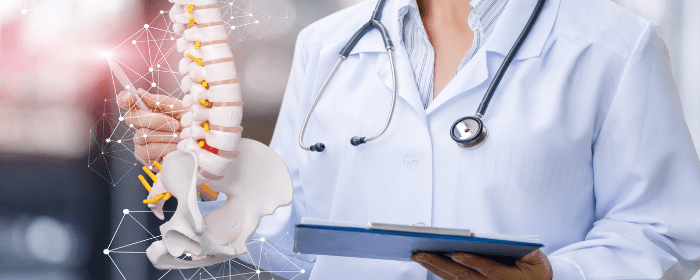Recent breakthroughs in the field of regenerative medicine continue to support the tremendous healing potential of stem cell therapy. Until a few years ago, stem cell research was limited to only what could be gathered from the research gathered from embryonic stem cells; this research was limited by the well-documented ethical concerns surrounding the practice of harvesting stem cells from embryonic sources.
Fortunately, alternative – and less controversial – sources of stem cells, harvested primarily from autologous bone marrow and adipose tissue have demonstrated promise in treating many diseases ranging from autoimmune conditions to myocardial infarctions.
Considering this, the ability of adult stem cells to undergo division and multipotent differentiation has garnered the attention of spinal surgeons and specialists around the world, specifically for the potential benefits of these stem cells in the treatment of a variety of spine issues related to neural damage, muscle trauma, disk degeneration as well as it potential in supporting bone and spine fusion.
Stem Cells in Spine Surgery
Although the rate of spinal surgery, and specifically lumbar, cervical and thoracolumbar fusions, has continued to rapidly increase over the last 20 year, there has not yet been a breakthrough in surgical technology that has consistently demonstrated the ability to reduce reoperation rates associated with these procedures; additionally, these procedures have demonstrated little success in reducing the issue of pseudoarthrosis in patients.
As a result, spinal surgeons have begun experimenting with using stem cells to support the process of bone growth and fusion. As stem cell research continued to evolve, the discoveries of the ability of mesenchymal stem cells (MSCs) harvested from bone marrow, adipose tissue, and skeletal muscle differentiate when cultivated in the correct microenvironment has led to the realization that these stem cells demonstrated a significant effect of the process of spinal fusion.
Adding to the potential benefits of these stem cells are several animal model studies confirming the benefits of the much more available, and much easier harvested adipose-derived stem cell (ADSC). In fact, several of these animal studies have confirmed similar fusion results observed when comparing MSCs and ADSCs.
Stem Cells in Disc Regeneration
Changes occurring in the discs of the spine and specifically starting in the second decade of life, contribute to decreased disc height that contributes to the impingement of nerves and the development of lower back pain consistent with Degenerative Disc Disease.
Until recently, treatment of Degenerative Disc Disease was limited to conservative management techniques, including work and lifestyle modifications, physical therapy, medication, and epidural injections, or surgery in the form of disc replacement or spinal fusion.
Although realizing the actual effects of stem cells therapy for treating this condition has been limited in humans (primarily due to concerns associated with the potential for an immune reaction to allogeneic stem cells in humans), several animal studies have demonstrated decreased disc degeneration as well as significant improvement in height and hydration of previously damaged discs. In addition, small-scale studies in humans have demonstrated improvements in pain and disability within three months of stem cell treatment.
Considering this, Schroeder J et al. call for larger clinical trials designed to further explore the benefits associated with using stem cell therapy to treat Degenerative Disc Disease.
Stem Cells in Treatment of Spinal Cord Injury (SCI)
Spinal Cord Injury (SCI) resulting from damage to the spinal cord most often is the result of motor vehicle accidents, falls, or injuries occurring during sports, work, or in the home; currently, the World Health Organization (WHO) estimates that worldwide between 250,000 and 500,000 people suffer an SCI each year[1].
SCIs range in severity, but most often are accompanied by some degree of tissue damage and/or cell death. As a result, spine surgeons have been exploring the potential of stem cell transplantation with the hope of supporting functional recovery after an SCI is sustained.
There are several phases associated with SCI. Regardless of the specific phase associated with an SCI, scientists have realized that creating a microenvironment that enhances neuron and axon regeneration appears to be the most desirable outcome of stem cell therapy. It is hypothesized that this is best achieved by suppression of the inflammation that typically accompanies cell apoptosis and necrosis.
Although embryonic stem cells appear to provide greater differentiation than adult stem cells, the ethical concerns surrounding their use have limited further exploration of these potential benefits. However, to date, adult mesenchymal stem cells (MSCs) used in the treatment of SCI have not demonstrated immunologic reactions and have demonstrated the potential to promote axonal regeneration, suppress demyelination, induce nerve regeneration, and induce nerve regeneration.
Unfortunately, the in vivo differentiation of MSCs into neuron-like cells has been documented to be inefficient, meaning that MSCS is currently not capable of directly repopulating or physically restoring the tissue damaged in SCI.
While there have since been studies exploring the transplantation of neural stem cells (NSC) that have demonstrated sensory and motor improvements after stem cell transplantation and when combined with other cell and growth factors, these improvements were not statistically significant. Considering this, the authors of this study indicate that it’s difficult to provide a definitive statement on the clinical potential of stem cell therapy for the treatment of SCI.
In conclusion, the authors point out that there are additional areas, including iatrogenic nerve and muscle injury resulting from spinal surgery, that have not yet been clinically addressed. The authors also point out that greater standardization of in vitro experimentation and animal models may aid in the speed of translation of stem cell therapy in spinal surgery.
Source: (n.d.). Stem cells for spine surgery – NCBI – NIH. Retrieved from https://www.ncbi.nlm.nih.gov/pmc/articles/PMC4300930/
[1] “sheets/detail/spinal-cord-injury – WHO | World Health Organization.” 19 Nov. 2013, https://www.who.int/news-room/fact-sheets/detail/spinal-cord-injury.


 St. Petersburg, Florida
St. Petersburg, Florida
